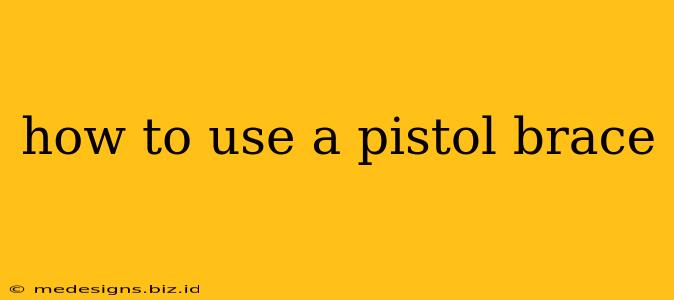Pistol braces have become increasingly popular, offering a stable shooting platform for handguns. But understanding how to properly and safely use one is crucial. This guide will walk you through the fundamentals, ensuring you can utilize your pistol brace effectively and responsibly.
What is a Pistol Brace?
Before diving into usage, let's clarify what a pistol brace is. It's a stabilizing device attached to the rear of a pistol, designed to improve shooting accuracy and control. Unlike a traditional stock, a pistol brace is not intended to be shouldered; instead, it's braced against the user's arm or shoulder. This distinction is key for legal compliance.
Understanding the Legal Aspects
Crucially, the legality of pistol braces can vary significantly depending on your location and specific regulations. Always check your local and federal laws before purchasing or using a pistol brace. Misunderstanding these laws can lead to serious legal consequences. Consult with legal counsel or your local law enforcement agency if you have any questions regarding compliance.
Proper Mounting and Attachment
The first step is ensuring the pistol brace is correctly attached to your pistol. This typically involves attaching the brace to the pistol's receiver via a buffer tube or similar mechanism. Refer to your specific pistol brace and firearm's instructions for detailed mounting procedures. Improper attachment can compromise safety and stability.
Key Considerations During Mounting:
- Secure Fasteners: Ensure all screws, pins, and other fasteners are correctly tightened and secured. Loose components can lead to malfunction or injury.
- Correct Orientation: The brace must be properly oriented to ensure correct functionality and avoid interference with the firearm's operation.
- Compatibility: Always verify that the pistol brace is compatible with your specific model of handgun. Using an incompatible brace can result in serious issues.
Safe Handling and Shooting Techniques
Now that your brace is correctly mounted, let's cover safe handling and shooting techniques:
Bracing Techniques:
- Arm Brace: This involves bracing the pistol brace against the inside of your forearm, providing stability and control.
- Shoulder Brace (with caution): While not the intended method, some users might find bracing against the shoulder more comfortable. However, this method must comply with all local and federal regulations; it's crucial to confirm that this is a permitted use in your area. Improper shouldering can be considered illegal in many jurisdictions.
Regardless of your chosen bracing technique, always maintain a firm grip on the pistol, ensuring a stable and controlled shooting platform.
Safety Precautions:
- Always treat every firearm as if it were loaded. This is the fundamental rule of firearm safety.
- Keep your finger off the trigger until ready to shoot.
- Never point the firearm at anything you don't intend to shoot.
- Be aware of your surroundings and ensure a safe backstop.
- Wear appropriate eye and ear protection.
Maintenance and Cleaning
Regular cleaning and maintenance are essential to ensure the longevity and reliability of your pistol brace and firearm. Follow the manufacturer's instructions for cleaning and lubrication. Pay close attention to the moving parts of the brace to prevent malfunctions.
Conclusion
Using a pistol brace effectively and safely requires understanding both its mechanics and the relevant legal implications. By following the guidelines in this comprehensive guide, you can enhance your shooting experience while prioritizing safety and compliance with the law. Remember to consult with legal counsel and review local and federal laws before using a pistol brace.
